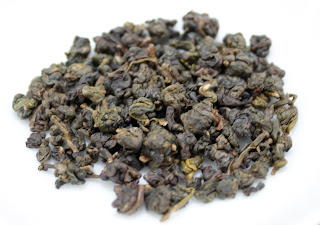Inspired by the creative tea descriptions written by our amazing tea staff, I added some photos of the various teas they describe. In this series, there are three photos per tea. The first is the dry tea leaf, the second is the tea soup or brewed tea. For the tea soup we tried to include at least two infusions, if not three. The final photo is the tea leaf after it was steeped. All but two photos were taken by Andrew Hess.
Jonathan chose the Li Shan 2008, stating:
"This tea will obliterate your conception of black tea. It's malty, smoky, slightly fruity, spicy, delicate and terribly smooth. Reminds me of a haunted house!"
 |
| The tea water is rich and red, sweet like fruit. |
and the Twisted Leaf Formosa, stating:
"A great introduction into the world of Formosa. Rose-petal aroma, up front honey sweetness and
nice malty backbone. It's a delicate and multi-layered tea able to conjure up balmy summer feelings even in the darkest winters." Dark winters indeed, and Eugene, Oregon sure has seen its share of those.
 |
| This Formosa Oolong is processed in the twisted leaf style in which the leaves are rolled, but not in a bag, so that the leaves do not roll into tight balls. |
 |
| Possibly, it is this sunny red that calls out like a beacon, lighting the way for the day's next sunrise. |
 |
| Formosa Oolong... also known as Eastern Beauty, Oriental Beauty, Silver tipped Oolong, Bai Hao Oolong, Dong Fang Mei Ren, and Pong Hong Te to name a few. |
Of the An Xi Iron Goddess, Mical says, "Drink this when you're cranky and feel your heart open."
 |
| This is an example of traditional oxidation and roast for An Xi Goddess. |
 |
| Heart opening goodness. |
 |
| We often recommend this tea for people that like heavy flavors, such as coffee. |
and of the Li Shan Charcoal Roast Autumn 2009 she writes:
"This tea tastes like fall: hints of wood smoke and sugars like you'd find in roasted root vegetables. Wrap this tea around you when you're cold."
 |
| Charcoal roasting adds full body mouth feel that is both bold and delicate. |





No comments:
Post a Comment